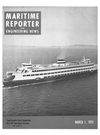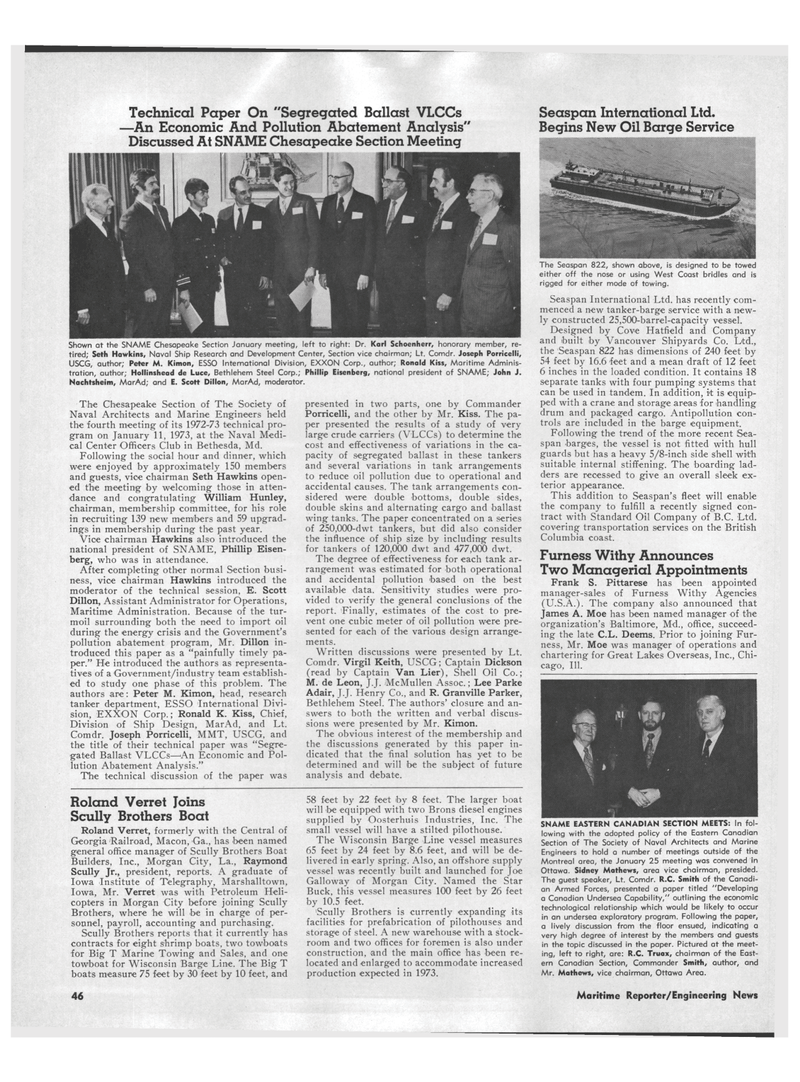
Page 38: of Maritime Reporter Magazine (March 1973)
Read this page in Pdf, Flash or Html5 edition of March 1973 Maritime Reporter Magazine
Technical Paper On "Segregated Ballast VLCCs —An Economic And Pollution Abatement Analysis"
Discussed At SNAME Chesapeake Section Meeting
Seaspan International Ltd.
Begins New Oil Barge Service
Shown at the SNAME Chesapeake Section January meeting, left to right: Dr. Karl Schoenherr, honorary member, re- tired; Seth Hawkins, Naval Ship Research and Development Center, Section vice chairman; Lt. Comdr. Joseph Porricelli,
USCG, author; Peter M. Kimon, ESSO International Division, EXXON Corp., author; Ronald Kiss, Maritime Adminis- tration, author; Hollinshead de Luce, Bethlehem Steel Corp.; Phillip Eisenberg, national president of SNAME; John J.
Nachtsheim, MarAd; and E. Scott Dillon, MarAd, moderator.
The Chesapeake Section of The Society of
Naval Architects and Marine Engineers held the fourth meeting of its 1972-73 technical pro- gram on January 11, 1973, at the Naval Medi- cal Center Officers Club in Bethesda, Md.
Following the social hour and dinner, which were enjoyed by approximately 150 members and guests, vice chairman Seth Hawkins open- ed the meeting by welcoming those in atten- dance and congratulating William Hunley, chairman, membership committee, for his role in recruiting 139 new members and 59 upgrad- ings in membership during the past year.
Vice chairman Hawkins also introduced the national president of SNAME, Phillip Eisen- berg, who was in attendance.
After completing other normal Section busi- ness, vice chairman Hawkins introduced the moderator of the technical session, E. Scott
Dillon, Assistant Administrator for Operations,
Maritime Administration. Because of the tur- moil surrounding both the need to import oil during the energy crisis and the Government's pollution abatement program, Mr. Dillon in- troduced this paper as a "painfully timely pa- per." He introduced the authors as representa- tives of a Government/industry team establish- ed to study one phase of this problem. The authors are: Peter M. Kimon, head, research tanker department, ESSO International Divi- sion, EXXON Corp.; Ronald K. Kiss, Chief,
Division of Ship Design, MarAd, and Lt.
Comdr. Joseph Porricelli, MMT, USCG, and the title of their technical paper was "Segre- gated Ballast VLCCs—An Economic and Pol- lution Abatement Analysis."
The technical discussion of the paper was
Roland Verret Joins
Scully Brothers Boat
Roland Verret, formerly with the Central of
Georgia Railroad, Macon, Ga., has been named general office manager of Scully Brothers Boat
Builders, Inc., Morgan City, La., Raymond
Scully Jr., president, reports. A graduate of
Iowa Institute of Telegraphy, Marshalltown,
Iowa, Mr. Verret was with Petroleum Heli- copters in Morgan City before joining Scully
Brothers, where he will be in charge of per- sonnel, payroll, accounting and purchasing.
Scully Brothers reports that it currently has contracts for eight shrimp boats, two towboats for Big T Marine Towing and Sales, and one towboat for Wisconsin Barge Line. The Big T boats measure 75 feet by 30 feet by 10 feet, and presented in two parts, one by Commander
Porricelli, and the other by Mr. Kiss. The pa- per presented the results of a study of very large crude carriers (VLCCs) to determine the cost and effectiveness of variations in the ca- pacity of segregated ballast in these tankers and several variations in tank arrangements to reduce oil pollution due to operational and accidental causes. The tank arrangements con- sidered were double bottoms, double sides, double skins and alternating cargo and ballast wing tanks. The paper concentrated on a series of 250,000-dwt tankers, but did also consider the influence of ship size by including results for tankers of 120,000 dwt and 477,000 dwt.
The degree of effectiveness for each tank ar- rangement was estimated for both operational and accidental pollution based on the best available data. Sensitivity studies were pro- vided to verify the general conclusions of the report. Finally, estimates of the cost to pre- vent one cubic meter of oil pollution were pre- sented for each of the various design arrange- ments.
Written discussions were presented by Lt.
Comdr. Virgil Keith, USCG; Captain Dickson (read by Captain Van Lier), Shell Oil Co.;
M. de Leon, J.J. McMullen Assoc.; Lee Parke
Adair, J.J. Henry Co., and R. Granville Parker,
Bethlehem Steel. The authors' closure and an- swers to both the written and verbal discus- sions were presented by Mr. Kimon.
The obvious interest of the membership and the discussions generated by this paper in- dicated that the final solution has yet to be determined and will be the subject of future analysis and debate. 58 feet by 22 feet by 8 feet. The larger boat will be equipped with two Brons diesel engines supplied by Oosterhuis Industries, Inc. The small vessel will have a stilted pilothouse.
The Wisconsin Barge Line vessel measures 65 feet by 24 feet by 8.6 feet, and will be de- livered in early spring. Also, an offshore supply vessel was recently built and launched for Joe
Galloway of Morgan City. Named the Star
Buck, this vessel measures 100 feet by 26 feet by 10.5 feet. 'Scully Brothers is currently expanding its facilities for prefabrication of pilothouses and storage of steel. A new warehouse with a stock- room and two offices for foremen is also under construction, and the main office has been re- located and enlarged to accommodate increased production expected in 1973.
Seaspan International Ltd. has recently com- menced a new tanker-barge service with a new- ly constructed 25,500-barrel-capacity vessel.
Designed by Cove Hatfield and Company and built by Vancouver Shipyards Co. Ltd., the Seaspan 822 has dimensions of 240 feet by 54 feet by 16.6 feet and a mean draft of 12 feet 6 inches in the loaded condition. It contains 18 separate tanks with four pumping systems that can be used in tandem. In addition, i-t is equip- ped with a crane and storage areas for handling drum and packaged cargo. Antipollution con- trols are included in the barge equipment.
Following the trend of the more recent Sea- span barges, the vessel is not fitted with hull guards but has a heavy 5/8-inch side shell with suitable internal stiffening. The boarding lad- ders are recessed to give an overall sleek ex- terior appearance.
This addition to Seaspan's fleet will enable the company to fulfill a recently signed con- tract with Standard Oil Company of B.C. Ltd. covering transportation services on the British
Columbia coast.
Furness Withy Announces
Two Managerial Appointments
Frank S. Pittarese has been appointed manager-sales of Furness Withy Agencies (U.S.A.). The company also announced that
James A. Moe has been named manager of the organization's Baltimore, Md., office, succeed- ing the late C.L. Deems. Prior to joining Fur- ness, Mr. Moe was manager of operations and chartering for Great Lakes Overseas, Inc., Chi- cago, 111.
SNAME EASTERN CANADIAN SECTION MEETS: In fol- lowing with the adopted policy of the Eastern Canadian
Section of The Society of Naval Architects and Marine
Engineers to hold a number of meetings outside of the
Montreal area, the January 25 meeting was convened in
Ottawa. Sidney Mathews, area vice chairman, presided.
The guest speaker, Lt. Comdr. R.C. Smith of the Canadi- an Armed Forces, presented a paper titled "Developing a Canadian Undersea Capability," outlining the economic technological relationship which would be likely to occur in an undersea exploratory program. Following the paper, a lively discussion from the floor ensued, indicating a very high degree of interest by the members and guests in the topic discussed in the paper. Pictured at the meet- ing, left to right, are: R.C. Truax, chairman of the East- ern Canadian Section, Commander Smith, author, and
Mr. Mathews, vice chairman, Ottawa Area. 46 Maritime Reporter/Engineering News

 37
37

 39
39
